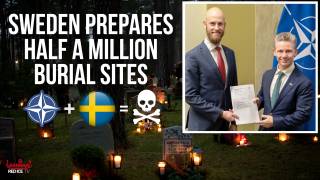N.A.T.O. Gladio, and the strategy of tension
Source: threemonkeysonline.com
 In August of 1990, Italian Prime Minister Giulio Andreotti confirmed that a secret army, called Gladio, had existed in Italy throughout the Cold War period. His revelations were shocking, not simply because they admitted to something that had long been denied (including by Andreotti himself when speaking to a judicial enquiry in 1974 in his capacity as Italian Defence Minister), but because he went on to claim that a network of secret 'stay-behind' armies had been set up all throughout the North Atlantic Treaty Organisation countries. In short, this was an issue that involved far more than just Italy.
In August of 1990, Italian Prime Minister Giulio Andreotti confirmed that a secret army, called Gladio, had existed in Italy throughout the Cold War period. His revelations were shocking, not simply because they admitted to something that had long been denied (including by Andreotti himself when speaking to a judicial enquiry in 1974 in his capacity as Italian Defence Minister), but because he went on to claim that a network of secret 'stay-behind' armies had been set up all throughout the North Atlantic Treaty Organisation countries. In short, this was an issue that involved far more than just Italy.As details emerged into the public realm, the story became ever more incredible. In the wake of WWII, at the start of the Cold War, intelligence agencies led primarily by the US and UK set up a network of agents and secret arms dumps across Europe, a network that would remain secret but active throughout the Cold War. An unregulated heavily armed military network.
The subsequent scandal that broke across Europe was limited by the outbreak of the first Gulf War (Saddam Hussein invaded Kuwait in August 1990), and fifteen years after Andreotti's confirmation, Gladio, and the NATO stay-behind network, remain largely the subject of a host of unanswered questions. Why, the casual reader might ask, should one be interested in a secret Cold War structure? Partly because there are so many unanswered questions. The existence of the network is a fact. It has, at this stage, been confirmed by numerous heads of state, by three parliamentary investigations (Italy, Belgium and Switzerland), and not least by a bizarre* denial and subsequent confirmation of its existence by NATO itself in 1990. And yet, apart from those involved in the network, very few people know for sure how the network functioned, or how it defined its own role. There is enough evidence and personal testimony to suggest, at best, casual links to right wing terrorist groups active throughout the '70s and '80s, and at worst that this network was itself responsible for implementing the so-called 'strategy of tension'; that is the deliberate use of terrorism to scare the voting population of a given country into a rightward shift politically, towards a 'law and order' style government. The questions are unanswered because, even in the case of parliamentary investigations, when researching the subject one sooner or later runs up against official secrecy regulations. Underlining the 'off limits' nature of the subject, a NATO diplomat was quoted as saying, "I wouldn't expect too many questions to be answered, even though the Cold War is over. If there were any links to terrorist organisations, that sort of information would be buried very deep indeed" [Reuters 15th November 1990].
Amongst those searching for answers is Dr. Daniele Ganser, a Swiss historian and Senior Researcher at the Center for Security Studies at the Federal Institute of Technology (ETH) in Zurich, and author of NATO's Secret Armies - Operation Gladio and Terrorism in Western Europe [Published by Frank Cass].
One thing Ganser is quick to point out, when talking about the origins of the network, is that one needs to take into consideration the immediate post-war atmosphere to understand the motivations behind the network. "It's got to be stressed that some of these were very decent men," he says of the intelligence officers who from 1945 onwards were in agreement that a) the Soviet Union was the new enemy, and b) lessons from the Nazi Blitzkrieg of Europe had to be learned. "The set up of clandestine operations in enemy territory is extremely problematic," continues Ganser. "They were preparing for the worst possible scenario, so they decided to set up the secret armies". Investigations during the ‘90s in Belgium uncovered invaluable details on the networks structure. In the case of Belgium, and many other NATO countries, the first step was the establishment of a tri-partite committee between the host country, the UK and the US. Later, in 1948 a general body to co-ordinate amongst the various countries of Western Europe, the so-called Western Union Clandestine Committee was set up. The WUCC was, in 1951, subsumed into NATO, changing its title to the Clandestine Planning Committee. A second body was also established, the Allied Clandestine Committee (ACC). After France's exit from NATO, these committees' headquarters were transferred to Brussels. "In all cases these networks were set up clandestinely," comments Ganser, "and in some cases right-wing people were recruited, because you wanted to be sure that they would be ideologically committed against communism. So in Germany some members of the Nazi network, for example, were recruited".
The secret armies functioned as part of the Cold War, but the presence of ex-Nazis, Fascists and right wing extremists brings up the problematic question of what enemy these secret soldiers had in mind? A Soviet invasion, or the growth of domestic, democratically supported communism? "It's not a black and white phenomenon," agrees Ganser. "When they were first discovered, the press asked the question 'safety net or source of terror?' and that's the problem. A safety net is something good, and something everyone wants. It's smart, and everybody involved would be praised for setting it up. A source of terrorism is obviously something very negative, that nobody wants. What you have is the same tool, which means a few trained men, hidden arms and explosives and an international network, which can be used either as a safety net in the case of a Soviet invasion, which would seem like great foresight, or in the absence of an invasion something that can be used in domestic operations. The countries that did form parliamentary investigations to investigate got to a stage where they found that there were criminal links in various cases, but were unable to get to the bottom of it, due to official secrecy acts, so on the whole we have to talk about Gladio as something that's still untackled in terms of law and criminal process. It's too big..."
Ganser is one of the first academics to approach the topic from a European wide level. While information about the actions of the network have been shrouded by official secrecy, researchers have also, unfortunately, tended to examine the phenomenon on a national basis, rather than attempting to understand it on a wider level. "What you could see on an international academic level was this," says Ganser, who was born in the Italian speaking part of Switzerland, "when I went to the LSE in London, there were people who would consider events in Italy as part of a wider mess, that it was such a corrupt country anyhow, with the Mafia, the Catholic Church, Propaganda Due, the Masons, what have you! Where every crime can happen anyway, so Gladio was just another scandal. Andreotti though, had made it very clear that it was much larger than that. If you look at Germany, the conception was completely different. These are the guys from whom, if you buy stuff, you can really depend upon it, a Mercedes car or a Bosch drilling machine, and yet they too had a secret army and possible links to terrorism".
For many of us, despite being proud Europeans, we have a parochialism that tends to highlight the dramatic events in our own countries. For example, in Italy the Bologna bombing remains a vivid memory. A ferocious terrorist attack that killed 85 people. Investigation into the attack was consistently hampered and misled by Italian secret service agents - just one of many terrorist attacks in Italy with worrying links to military intelligence. Few Italians though remember that in the same year, 1980, a bomb exploded at Munich's Oktoberfest, killing 13 people. The bomb was initially linked to Gundholf Köhler, who died in the attack, a right wing extremist and member of the Wehrsportgruppe Hoffmann. Experts, though, suggested that the bomb was too complex to have been manufactured by the 21 year old. In 1981, a year later, an enormous arms cache was discovered by police near the village of Uelzen. The official explanation was that the arms were hidden by right wing terrorists, and controlled by a certain Heinz Lembke, but the volume and type of weaponry found threw into question this convenient explanation. Automatic weapons, chemical combat equipment, 50 anti-tank guns, 156 kg of explosives, 230 explosive devices and 258 hand grenades [NATO's Secret Armies, pg 206]. Investigative journalists linked Lembke to the German stay-behind army BND. Official investigations denied any links between Lembke and the Munich massacre. Heinz Lembke was found dead, hanging from a rope, while in police custody in 1981.
Violent right-wing terrorism did not just take place in the frontline of the Cold War, as Italy and Germany effectively became. Far behind the front line, in Belgium, in 1984 a bizarre operation occurred around Vielsalm in the Ardennes region. A squad of US Marines were parachuted into Belgium, and met by a member of the Belgian military intelligence. They hid for a fortnight before attacking the police station of Vielsalm, in a so-called Oesling exercise, killing a Belgian officer. One marine was injured during the operation, losing an eye. Initially the attack was passed off as terrorism, but was later proven to be the work of the American and Belgian military - as confirmed by the Senate investigations of 1991. Other attacks occured, where, as was the case in Vielsalm, arms and ammunition were taken. Arms that found their way subsequently to extremist groups.
One central question in the Belgian Senate investigation into the stay-behind network was whether it had been involved in the so-called Brabant Massacres of the 1980s. These were a group of attacks that occured in the area around Brussels called Brabant over a period of two years. Jewellers, restaurants, and in a number of cases supermarkets were attacked by a gang of heavily armed and ruthless men. In all the attacks very small amounts of money were taken, while "at the same time massive brutality and professionalism was employed" [NATO's Secret Armies pg 139]. For example, on November 9th 1985 on a busy Saturday, three armed hooded men entered a supermarket and started shooting. Eight people were killed, some while trying to escape. The money taken from the raid amounted to a couple of thousand pounds, and was found dumped in a canal in an unopened sack. The motive for the attacks, it could be safely concluded was not money. The Senate investigation failed to produce any links to the Gladio network in Belgium, but also noted that, having questioned uncooperative military intelligence officers, "the silence which has been kept on the identity of the agents [of the network] does not allow the judges to carry out the necessary verifications in order to establish the whole truth" [NATO's Secret Armies pg Pg140].An official report published on the Brabant Massacres in 1990, before the discovery of the secret army network, had concluded that the killers had official links: “According to the report, the killers were members or former members of the security forces – extreme right-wingers who enjoyed high-level protection and were preparing a right-wing coup” [NATO’s Secret Armies, pg 145]
The right wing terrorist attacks that occured during the '70s and '80s in Europe are a fact. In many cases, like the Bologna train station massacre for example, it has been proven that there was some sort of link between members of military intelligence and those who carried out the attack. What's not clear though is whether a command and control structure existed within the Gladio structure, authorising attacks against civilian targets. There are different theories, as Ganser explains: "Theory one is the runaway agent, where NATO and top Generals didn't know anything about it, and later on were very sorry that some crazy guys went berserk. It can happen, but I don't think military structures function that way. From my studies of military structures, I'm convinced that the hierarchy plays a central role in all military operations, and these were military operations. This would mean that the strategy of tension was possibly, and I can't prove it, a deliberate strategy. Not a mistake, but something which was planned and which actually worked".
Continuing, he explains "Eastern Europe had the Warsaw pact, and obviously if Moscow didn't want something to happen there, they just sent the tanks in. End of story. It was clear. In Western Europe it was more delicate. We were free countries, if you want. At the same time we had communist parties that were very strong in countries like France and Italy, less strong elsewhere but they existed. So NATO was scared to be weakened from within. If you take France or Italy, or Greece or Turkey, where a group of parliamentarians could say 'we wan't to leave NATO', for example the communists; or they could say, 'if we get in to Government, we might say something to our allies in Moscow, because we actually agree with them more than with Washington and London', such a situation, seen from a NATO perspective was of the greatest danger. You couldn't want earnestly to have a Greek socialist prime minister taking the country out of NATO. You lose a country. You couldn't want an Italian communist leader becoming so famous and so strong that they actually put him into government in the Defence Ministry. It was a nightmare for the military. Military intelligence officers have described it in those terms to me. So this is the strategic framework to handle the problem. The strategy of tension, (where you have to be really evil - Ganser underlines - because you kill civilians). You have to plant bombs in public places and kill civilians. This happened in a number of countries in Western Europe during the Cold War, but it's not clear who was behind these acts. From thereon we have to speculate. If these bombs were planted as part of the stay-behind framework, then it was deliberate. The killing was then attributed to the left wing, which became discredited. They lost strength. Secondly the State could call for more power for the security services and the Defence Ministry, with all these terrorists running around. So the strategy of tension can work, and it is possible that it was implemented. It's quite possibly the most sensitive topic from the Cold War in Europe".
The most sensitive topic, in part, because the system existed with the tacit agreement of our elected leaders. "It's been proven that the secret services and Defence Ministries did not do this alone," Ganser points out. "They always went to the highest representative of the executive and asked for his approval. Here you have the same problem. Assume you're the Prime Minister, and I come to you as the Defence Minister and say that we have this secret army, put in place in case of a Soviet invasion, that has to remain secret. Is that a good thing? Is it a conspiracy? You as Prime Minister would probably respond, 'o.k, don't give me too many details, this could be politically sensitive' etc. The problem is we don't know how Prime Ministers responded. Take, for example, my research on P26, the Swiss stay-behind army, we don't know exactly how these conversations happened. One chief of staff, the highest officer in Switzerland, told me that he went to the Government, the federal councillors as we call them, and he told them about the stay-behind army. They listened to him, and didn't say anything. This is the plausible denial defence. You don't say anything. You don't sign any documents. You just approve silently, and the story goes on. The Defence dept. that hides the funds required for maintaining the network, putting it against building a new runway strip etc. Everybody would silently agree. There was no explicit proof that the highest levels were involved. But in many cases we can now show that it was not a run-away structure, that it was part of the security structure of Western Europe. But it was in part illegal, because it was not directly controlled by the elected legislature, the parliamentarians".
The reason for top-level security, the Cold War, has been finished for over fifteen years, and yet the archives remain closed. Furthermore, the archives of ex-communist States have essentially been purged of material that may throw light on Gladio and NATO. "It would be extremely interesting for historians to enter the archives to learn, for example about information regarding the stay-behind armies etc, but we don't get access. The archives of MI6, CIA, BND, SISMI, whatever, we don't get access or virtually no access to their archives. It would have been great to jump into the archives of the enemy, and see what the enemy had written about us, because you can learn a lot that way. The western Secret Services were smarter, though, and they went to the Stasi archives in Berlin, went there and cleared them all out. People in the Stasi archives, who worked there, confirmed to me that basically the German Secret Service, the CIA and the British Secret Service were there first and cleared it out. So for us, all we have is history. We can talk to people involved, people who in many cases are close to dying and want to talk about their lives, who talk about how they saw it, what they did, why they did it etc. They have a different outlook on life". With the weary resignation of someone who has made a number of requests under the Freedom of Information act, most doomed to failure, Ganser continues, "but people in power they will never say anything, they say forget about it. I asked people at NATO, Supreme Allied Headquarters Europe, and they know about it; I explained to them the structures, and they claimed they knew nothing about it. Deny everything, that's the strategy".
The implications of Ganser's research are both terrifying and current. Did we really have State-sponsored terrorism in Europe, in the name of discrediting left-wing democratic movements? Was there a cynical policy that involved killing innocent civilians for the supposedly greater good? When asked whether we have any evidence that these paramilitary networks have been disbanded, Ganser laughs, struck by the absurdity: "We just have the word of those who set it up, that they've closed it down again. That's really the evidence we have. It's not really much evidence, certainly for academics or historians". It may seem distasteful to question the integrity and direction of western intelligence agencies, while we are engaged in the 'war on terror', but as long as questions remain about the 'strategy of tension', and as long as serious academics are prevented from entering intelligence archives, scepticism about official intent seems more than a little prudent. "What you may have, if you translate our experience from the Cold War to the current day situation, is that a strategy of tension is still being implemented, but this time against the Muslims," conjectures Ganser. "We all know that the west is dependent upon oil, and a pretext is needed to develop more operations in Iran, Iraq etc. We can't just go there and invade them, so we have to have this idea that they're trying to kill us, then it's possible, or at least imaginable that a strategy of tension in which the Muslims are playing the role that the communists played in the Cold War, is happening. It's too complicated though, everything is happening too fast, and there's very little data available".
Data is the key, and Ganser's book has shedloads of it. On a country-by-country basis he outlines the internal, domestic fight against communism, documented by the findings from three parliamentary investigations, and statements from the few involved in Gladio who have chosen to make public their involvement. This is not the realm of Roswell, aliens, and other such far-fetched conspiracy theories so beloved of the Internet generation. This is the story of a real, historically proven movement that operated in Europe. The strategy of tension remains a plausible theory to explain the vicious attacks across Europe. The onus should be on our elected governments to disprove it.
Notes
*In November 1990, in response to Andreotti's declaration that a NATO led secret army existed, NATO issued a categorical denial. The next day NATO explained that their denial had been false, while refusing to answer any further questions.
** After one attack, the money stolen was later found in a canal, in an unopened sack.
Article from: http://www.threemonkeysonline.com/
threemon_article_nato_gladio_
terrorism_strategy_of_tension.htm






















